If you do
NOT see the Table of Contents frame to the left of this page, then
Click here to open 'USArmyGermany'
frameset |
USAH Würzburg
7th Medical Command
Looking for more information from military/civilian
personnel assigned to or associated with the U.S. Army
in Germany from 1945 to 1989. If you have any
stories or thoughts on the subject, please contact me . .
|
|
|
|
|
| |
| USAH
Würzburg History |
|
| (Source: USAREUR
Military History Office - Online Medical Histories, 2002) |
| CHRONOLOGY
of the USAH Würzburg |
| 1935 |
|
24
December |
|
Groundbreaking. |
|
|
|
|
|
| 1937 |
|
20
October |
|
Opening
ceremonies; the 300-bed Hospital is operated by Sanitätsabteilung
15. |
|
|
|
|
|
| 1938 |
|
11
November |
|
The
Sanitätsabteilung 40 from the German 4th Panzer Division assumes
operations of the hospital.. |
|
|
|
|
|
| 1939 |
|
1
September |
|
With
the advent of WWII, the hospital is designated a Reservelazarett
and becomes a 750-1500 bed unit. |
|
|
|
|
|
| 1945 |
|
8
May |
|
The
US Army 107th Evac Hospital occupies the former German hospital.
Commanding Officer of the 107th is COL Henry W. Daine. |
|
|
27
September |
|
The 124th Evac Hospital replaces the 107th Evac Hosp. CO of
the 124th is COL Don S. Wenger. |
|
|
|
|
|
| 1946 |
|
17
April |
|
The
112th Evac Hosp replaces the 124th. CO is COL George W. McCoy,
Jr. |
|
|
|
|
|
| 1947 |
|
1
February |
|
The
57th Field Hospital replaces the 112th Evac Hosp. CO is LTC
R.S. Anderson. |
|
|
|
|
|
| 1951 |
|
1
January |
|
The
10th Field Hospital replaces the 57th Fld Hosp. CO is COL
James W. Howard. |
|
|
|
|
|
| 1962 |
|
7
June |
|
The 10th Fld Hosp is redesignated as the 10th Evacuation Hospital.
CO is COL R.S. Anderson. |
|
|
|
|
|
| 1965 |
|
16
August |
|
The 33rd Field Hospital assumes operation of the USAH in Würzburg.
CO is COL D.E. Carle. |
|
|
|
|
|
|
|
|
|
|
|
|
|
10TH
FIELD HOSPITAL / 10TH EVACUATION HOSPITAL
|
|
|
| (Source: USAREUR
Military History Office - Online Medical Histories, 2002) |
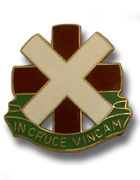 10th Field Hopsital DI
10th Field Hopsital DI
Due to the pressing need for field hospitals in the European Command,
the 10th Field Hospital was reactivated on 25 October 1949 and
assigned to the European Command. Initially the unit was attached
to the 98th General Hospital at Munich, Germany, but on 9 January
1950, the unit was moved to Regensburg, Germany, where it operated
the US Army Hospital plant.
During October, 1950, the hospital received movement orders, transferring
the unit to the Würzburg Military Post, and on 20 December
1950, the unit moved to Würzburg and occupied the US Army
hospital plant formerly operated by the 57th Field Hospital.
The hospital building was erected in 1937 as a German Army hospital
and served the German Air Force during World War II until it was
requisitioned by the US Army in 1945. During this period of emergency
the hospital building operated continuously and intensively with
very little upkeep and maintenance being performed. Paint, plaster
work, and the flooring in particular were in a poor state of repair.
Due to this condition and also due to the EUCOM hospital expansion
program, a reconstruction project was approved by the Medical
Division of the Headquarters of the European Command. Under the
supervision of the Würzburg Military Post Engineer Section,
the work was planned in phases, so as to allow continuous operation
of the hospital while work progressed.
Major work accomplished as a part of the reconstruction was the
rebuilding of all floors, resurfacing of the exterior, reconstruction
of nine sections into nine wards complete with doctor's office,
nurse's office, ward kitchen and utility room and patching and
painting of all walls and ceiling. In addition a 120 seating capacity
theater was built on the fifth floor center section, attic sections
on the fourth floor were rebuilt into Red Cross' recreation facilities
and a gymnasium, and a 150 seating capacity patients' mess hall
and kitchen were built on the second floor, north wing.
The project was scheduled for completion in November 1951. Due
to difficulty in obtaining material and certain equipment, and
the general poor quality of the reconstructed dibenol flooring,
some of which had to be redone, the work was not completed till
the third week of January 1952. On 1 February, 1952, an Open House
was held celebrating the reconstruction.
1965
The US Army Hospital Wuerzburg is
located high on the Galgenberg Hill overlooking the city of Würzburg,
in the heart of Franconia. The hospital is a 6 story building
on a landscaped park area of approximately 14 acres.
The mission of the 10th Evacuation Hospital is to operate the
US Army Hospital Würzburg, function as headquarters for the
Wuerzburg Medical Service Area, and to train for employment as
an evacuation hospital, if necessary. The US Army Hospital Würzburg
presently has a 241 bed capacity. It is organized into three major
professional departments: Medicine, Surgery and Hospital Clinics
and Area Medical Service.
As headquarters for the Würzburg Medical
Service Area, the hospital provides logistical, administrative,
and professional technical support for two attached dispensaries,
the 210th General Dispensary at Kitzingen and the 269th Medical
Detachment at Wertheim, and three attached annexes, the 23rd Medical
Detachment at Wildflecken, the 24th Medical Detachment at Schweinfurt,
and the 31st Medical Detachment at Bad Kissingen. Dental service
is provided by the 123rd Medical Detachment (Den Svc) with Dental
Clinics at each annex and dispensary as well as at the hospital
in Würzburg. The 80th Medical Detachment (VFI) provides veterinary
services for the medical service area and also operates a small
animal clinic in Würzburg. The hospital and its attached
units provides medical services for approximately 34,000 authorized
personnel located within an area of about 3,500 square miles.
Ambulance services is furnished by the 549th Medical Company (Amb)
from the annexes and dispensaries to the hospital as well as from
this hospital to other hospitals in Frankfurt and Landstuhl.
|
|
|
|
|
|
|
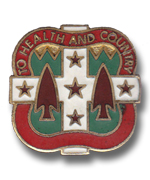 33rd Field Hopsital DI 33rd Field Hopsital DI |
|
| (Source: USAREUR
Military History Office - Online Medical Histories, 2002) |
|
On
9 December 1954, the 33rd Field Hospital was allotted to the regular
Army and on 9 February 1955 was reactivated in France.
It was again inactivated in France on 25 June 1962.
On 16 August 1965, the 33rd Fld Hosp was reactivated again in Würzburg,
Germany.
|
|
|
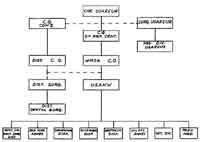 |
|
The
services rendered through the hospital and its attached units
are:
Primary hospitalization, dispensary and outpatient care, first
aid for local wage rate personnel employed in US Army industrial
type shops and depots, patient evacuation to and from dispensaries
and hospital. In addition, dental, veterinary, preventive
medicine and medical supply missions are accomplished throughout
its area of responsibility.
As the primary hospitalization unit, the 33rd Field Hospital
occupies a former German hospital that served the German Army.
The hospital is situated near the top of a hill overlooking
the 1200-year-old city of Würzburg in the Unterfranken
(region) of Bavaria. The hospital was constructed by the German
government at a cost of approximately $1,300,000. The building
was designed by engineers and architects of the German Army
and is laid out in an arcshape to conform to the contour of
the hill on which the structure is situated. Ground breaking
ceremonies were conducted on Christmas Day in 1935 with the
actual construction beginning on 2 January 1936.
Dedication ceremonies were conducted on 11 November 1937 and
the hospital became operational as a 300-bed hospitalization
and treatment facility supporting the German army troops and
their dependents stationed in this area.
When World War II started, the hospital bed space was increased
from 300 to 700 beds with no increase in building cosntruction.
Civilian physicians who served on the hospital staff during
this time state that during the last days of the war the patient
census increased to 1500 beds occupied.
On the 8th of May 1945, the 107th Evacuation Hospital of the
US Army assumed operation of the hospital plant and found
the facilities only slightly damaged by the wartime activities.
The German Army patients and staff occupying the facility
were transferred to other hospitals in the area remaining
under German control. |
| |
|
|
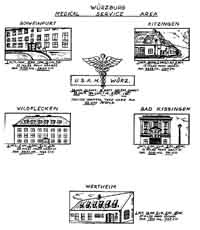 |
|
The 33rd Field Hospital operates the United States Army Hospital
Wuerzburg and is a 350-bed fixed installation serving the
Würzburg MSA (Medical Service
Area), an area exceeding 5,000 square miles. The major unit
supported is the 3rd Infantry Division, the North Bayern Support
District and a dependent and DAC (Department of the Army)
population.
The 33rd Field Hospital, as the major unit in the Würzburg
MSA, is operationally responsible for the Kitzingen Annex;
23rd Medical Detachment, Wildflecken; 24th Medical Detachment,
Schweinfurt; 31st Medical Detachment, Bad Kissingen; 269th
Medical Detachment, Wertheim; 80th Medical Detachment (VS)
and the 123rd Medical Detachment (DS). Assigned as ambulance
support for the MSA is the 549th Medical Company (Amb), a
7th Medical Brigade unit.
The mission of the 33rd Field Hospital is to operate the US
Army Hospital Würzburg and the Würzburg Medical
Service Area and attached units. It has a concurrent mission
of training as a Field Hospital in accordance with current
training directives for peace time and Emergency employment.
|
|
|
|
| 1971 |
| (Source: Email from Ernst Loomis) |
| I had the unbelievable good fortune to be stationed at USAH Wurzburg/33rd Field Hospital from May 1971 to July 1973. I had two years of high school German and a college degree in Art with a minor in classical music, and I had the time of my life looking at Baroque architecture and hearing classical music in Central Europe on my time off. I took three semesters of college-level German through the University of Maryland Extension Service at Leighton Barracks, and spent as much time as possible eating and traveling off-base. I lived in the “monastery” (Pius Seminar) across the street from the hospital.
I was more than dimly aware that I was living in the middle of history, but wish I had access to something like the internet back then. There were still some ruined buildings scattered throughout the city, but it was not until I started looking on the internet a few years ago that I discovered that the town once had a beautiful medieval town center, and was overflowing with Baroque architecture until it was firebombed in March, 1945. Back then, no one could even tell us whose air force led the attack. I now know it was the RAF, not the USAAF. The U.S. Army entered the city a couple of weeks later, but bungled the approach, giving die-hard Nazis time to organize stiff resistance, the results of which were still visible on a few of the buildings. It was not possible to restore any but the most important buildings, so most of the city was quite modern. Work was still in progress in the Residenz and the Neubaukirche at the time of my ETS. There was a rumor that the coal room beneath the hospital had a tunnel that ran all the way to the River Main, but I think that’s all it was – a rumor. The local municipal water had so much calcium in it – 10 times the maximum allowable amount in the USA – that it burned up the still that was brought in to supply distilled water (DW) for medical irrigation, and we had to buy DW from a supplier in town. We would borrow a vehicle from the Motor Pool and load it with huge glass bottles of pure water from the German firm that we had the contract with. Two pretty Korean ladies ran the snack bar downstairs. They made the best hamburgers I have ever tasted. I think the secret was the German mustard (senf). Colonel Hitzelberger was the CO of the hospital during most of my stay. Colonel MacDonald was Chief of Surgery, and he was very, very good. Doctor Bakos was a young doctor who was also excellent.
The officers in charge of the Operating Room, where I was assigned, were Captains Nichol, Lawyer, Kruger, Teague, in that approximate order, followed by Major Kirkland. Sgt. Jerry McBride was NCOIC of Nursing, Herr Oberoi (from India) had something to do with purchasing. Frau Stulpe was in charge of the Hospital Library. Ingrid Peruker was a secretary. Elsie cleaned our floor constantly.
There were dozens of other German nationals who helped staff the hospital, and they were all very competent and hard working.
I worked with Specialists Plum, Fields, Bjordahl, Carnes, Lashbrook, Lundgren, Testerman, Williams, Post, and Bruza. |
|
| |
| 67TH EVACUATION HOSPITAL |
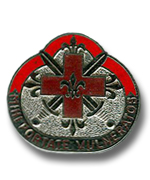 67th Evacuation Hopsital DI 67th Evacuation Hopsital DI |
| |
(Source: Wikipedia - 67th Combat Support Hospital (United States) - accessed July 28, 2012) |
The 67th Evacuation Hospital was activated on 21 November 1975 in Heidelberg, Germany and was assigned to augment the United States Army Medical Department Activity, Würzburg on the following day.
The 67th Evacuation Hospital was officially redesignated the 67th Combat Support Hospital on 16 July 1993.
The 67th Combat Support Hospital was deactivated at Würzburg, Germany on 19 October 2007 as part of the draw down of US forces in Germany. |
|
|
If you have more
information on the history or organization of the USAH Würzburg,
please contact me . . |
 |
|
| |
| Würzburg Medical Department Activity |
| |
| (Source: MEDCOM
Examiner, February 1983) |
|
Wuerzburg
MEDDAC: Crossroads of history and health
By Ruth Hamill
Editor's note: This is the sixth in a series of articles highlighting
7th MEDCOM facilities. Future issues of the MEDCOM Examiner will
feature each of the MEDCENs, MEDDACs and other MEDCOM treatment
facilities in a series of articles designed to further acquaint
people throughout 7th MEDCOM with each activity.
It has been said that whoever travels throughout West Germany is
bound to come across Wuerzburg somehow. History, art and natural
phenomena from many periods are found in this old town, located
in the heart of Germany, home of the Wuerzburg
MEDDAC.
The 100-bed 67th Evacuation
Hospital, located on a 14-acre kaserne on the
Galgenberg hillside, is the backbone of the MEDDAC. The facility
was built in 1935 when the expansion of the German army necessitated
a new and larger army hospital. It was originally constructed as
a 300-bed, six-story building with approximately 1,200 rooms. The
main building was designed in an arc shape to conform with the contours
of the hillside.
While ground-breaking ceremonies were held Dec. 24, 1935, construction
did not officially begin until Jan. 7, 1936. The opening ceremonies
were Nov. 11, 1937. After Sept. 1, 1939 and the beginning of hostilities,
the Germany Army Garrison Hospital Wuerzburg assumed the status
of a reserve hospital and was the parent unit for other reserve
hospitals in the vicinity of Wuerzburg. At this time operating beds
were increased to 700, with a maximum of approximately 2,000 beds
occupied at the end of World War II.
Americans arrive
The first U.S. Army unit to occupy the hospital was the 124th Evacuation
Hospital which began operating there on April 8, 1945. Since then,
the hospital has experienced a frequent turnover of tenant units.
Since April 16 of this year, the official designation has been the
67th Evacuation Hospital.
Today, the MEDDAC serves a total of about 40,000 people living within
a 2,500 square-mile area of responsibility. Most of these people
are assigned to the 3rd Infantry Division which is headquartered
in Wuerzburg. The hospital sees approximately 70 inpatients per
day and delivers about 72 babies per month.
The MEDDAC also provides support to four health clinics located
in Wildflecken, Schweinfurt, Kitzingen and Wertheim. The Wertheim
clinic was recently renovated, and the modernized clinic held its
grand opening on August 20, 1982.
Nearly 650 people are employed at the MEDDAC and outlying clinics,
including 35 Medical Corps officers (plus one U.S. civilian and
four local national physicians), 16 members of the Medical Service
Specialist Corps, 287 enlisted personnel, 120 U.S. civilians and
162 local nationals or third country nationals (1981 figures).
Col. Harry S. Spaulding became commander of the Wuerzburg MEDDAC
upon his arrival Sept, 1, 1981 from Fitzsimmons Army Regional Medical
Center in Denver, where he served as deputy commander. He is also
the chief of allergy and clinical immunology at the hospital, holds
an allergy clinic once a week and visits the outlying clinics on
a regular basis to give lectures and see patients.
The MEDDAC offers several other specialties including internal medicine,
pediatrics, dermatology, general surgery, orthopedics, ophthalmology,
OB-GYN, pathology, radiology, and psychiatry.
Patients needing more in-depth care are evacuated to Frankfurt or
Landstuhl Army Regional Medical Centers and approximately 15 people
are sent by MEDEVAC to the States each month.
Family practice popular
According to Col. Egon K.E. Schlatter, Chief of Professional Services,
all the clinic services offered are noteworthy, particularly the
Family Practice Clinic, which was begun in 1977. Headed by Maj.
Thomas H. Auer, MC, there are seven physicians and eight nursing
assistants or LPNs. Patients are divided among the physicians by
unit so that when individuals and families arrive in Europe they
immediately have a family physician responsible for their health
care. This has encouraged physician-patient relationships as well
as physician-unit relationships, greatly improving patient education
and unit communications. The Family Practice Service also maintains
approximately 15 percent of all hospital admissions and delivers
approximately 220 children per year.
The Wuerzburg DENTAC, commanded by Col. Thomas R. Tempel, is co-located
with the MEDDAC in Wuerzburg and operates clinics there, in Wildflecken,
Schweinfurt, Kitzingen, Wertheim and Bad Kissingen.
The Veterinary and Food Inspection Services are provided by the
80th Medical Detachment (VS) located at Faulenberg Kaserne and commanded
by Capt. Michael W. Yehle.
Historically wealthy
The elevation of the hospital grounds provides a very scenic view
of Wuerzburg, the city that poet, novelist and playwright Johann
Wolfgang von Goethe called one of the most beautiful in Germany.
It is located on the Main River 65 miles east of Frankfurt and marks
the beginning of one of the best known and most popular tourist
routes in Germany: The Romantic Road. Wuerzburg is in the center
of the Franconian wine district and the largest vineyards in Germany.
The ancient Marienberg Fortress, rebuilt after World War II bombings,
is located on a hill overlooking the city and the Palace of the
Prince Bishops, built by Balthasar Neumann in 1720, is in the center
of the city. Neumann is one of Germany's best known architects of
the Baroque. Much of both the fortress and the palace can be attributed
to the von Shoenborn family who, like the Medici's of Florence,
were enthusiastic patrons of the arts and architecture.
The Wuerzburg University, still thriving, was founded in 1582 and
is where Wilhelm Konrad Roentgen discovered the X-ray. The MEDDAC
enjoys an excellent relationship with the university, according
to Dr. Spaulding. About 25 patients receive supplemental care there
each month. In addition, the chiefs of the departments of surgery,
obstetrics and pediatrics, plus other staff members, have visited
the major university medical facilities which the MEDDAC utilizes.
Spaulding said, "We have met with university officials to improve
communications and work out the details for better care. As new
chiefs of major services arrive here, I want to make sure they all
get a chance to visit the university facilities. We also have some
emergency deliveries at the Frauenklinik. To make the transfers
smoother we give the mothers a card in German and English for them
to give the physician. It has all the pertinent information a physician
needs in the delivery room. We spend a lot of time and effort on
this type of activity, hoping to improve the German-American relationship.
After all, we are guests here."
The hospital also has a partnership unit at the German air force
base al Klingholz. The "Sanitaetsschule der Luftwaffe" invited about
25 members of the MEDDAC to a MASCAL exercise where 70 to 80 mock
casualties were evacuated from a base in Holland and in October
1982, 20 members of the Sanitaetsschule participated in the MEDDAC's
MASCAL exercise.
Enlisted programs
With the transition from a TDA to a TO&E posture for the organization,
emphasis has been on training programs for the enlisted personnel.
In cooperation with the local education center, a fully-funded EMT
education program has been established which is being conducted
in the hospital area. On-going constructions include duties, responsibilities
and authority of NCOs in the MEDDAC through NCOPP.
"Establishing and improving communications between staff sections
in the MEDDAC and the outlying health clinics is a priority," says
CSM Odel Couch. A new study guide has been developed to assist enlisted
soldiers in preparing for the Sergeant Morales Club board the SOM,
SOQ, SOY and promotion boards. "Participation of all MEDDAC personnel
has increased in community activities within the geographical area," he said.
The Wuerzburg MEDDAC hosted the first 7th MEDCOM CSM and Senior
NCO Conference in August 1982. The conference created an awareness
within MEDDAC senior NCOs of NCO responsibilities.
XO sums it up
Lt. Col. (P) Joseph K. Lillard, executive officer at the Wuerzburg
MEDDAC, has been there six months and summarizes the benefits of
the assignment. He says, "it has got to be one of the most delightful
places I have ever been in my career. Our relationship with the
community is excellent and these good things filter back to the
military. Both the civilian and the military communities are pleasant.
And our MEDDAC, while small enough for everyone to know each other,
is large enough to provide excellent medical care for all service
members and their families in the area."
|
|
| |
| (Source: STARS & STRIPES, Oct 21, 2007) |
After serving the nearby military communities since the 1940s, the Würzburg American Hospital officially shut its doors on Oct 19, 2007. During a ceremony marking the end of an era for Army medicine in Bavaria, the flag was lowered one final time.
On drawdown orders since September 2005, the hospital ceased emergency and surgical services the following June.
By this May, orders were given to clear the facilities and consolidate remaining medical operations on nearby Leighton Barracks by Sept. 30. |
 |
|
| |
| 31st Medical Detachment |
| |
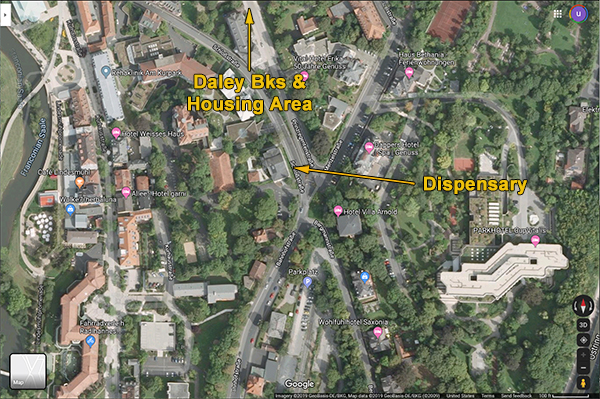
Former location of the Bad Kissingen Army Dispensary (GOOGLE Maps) |
| |
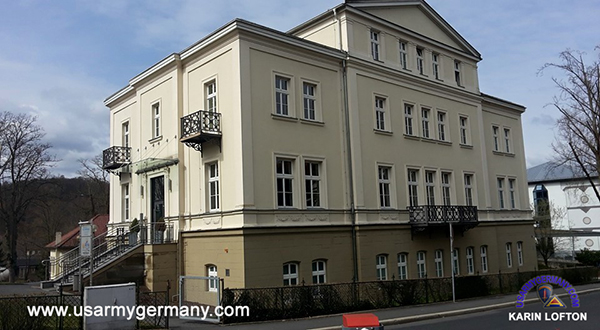
Former US Army dispensary on Schlossstrasse, Bad Kissingen (Karin Lofton) |
| |
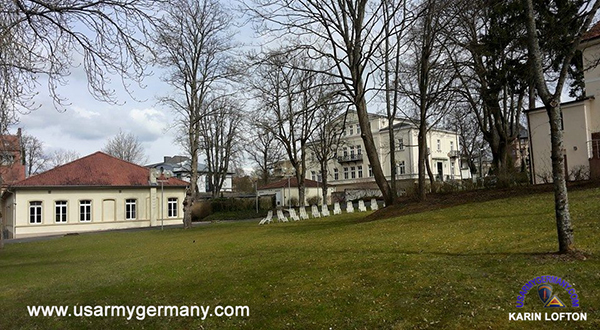
Former dispensary and O'Club in the background (Karin Lofton) |
| |
| 1972 |
| (Source: Email from Philip Koshkin) |
Click here to read the first part of Phil's personal recollections concerning the River Building in Würzburg.
Yes, I really did enjoy my tour.
When I enlisted in January 1972, I requested to be stationed in Germany - I had majored in German in college and studied German history, had traveled through Germany a few years previously, and wanted very much to return there. In fact, that's why I ended up extending my original tour for four months - I had contacted the Civilian Personnel Office in late 1974 about finding employment in Germany as a DAC after my ETS so I could spend more time in Europe. The extension gave me more time to work on that, and I succeeded - three days after mustering out at Ft. Dix, I was on a plane back to Germany to begin employment for two years as a counselor with the Drug and Alcohol Service at the 5th General USAH in Bad Cannstatt, outside of Stuttgart.
So in total, I spent five years in Germany (three active-duty, two as a civilian), and I must say that those years were among the best (and certainly the most exciting) of my life. There I was: a 20-something guy with some money in his pocket getting to travel all over Europe, familiar with the history and the main languages (French as well as German, plus some Spanish and a little Italian) - and early in my stint as a DAC, I even met the young woman who was, among other things, a great traveling companion and whom I later married! Hey, what was not to like?!?
With regard to Bad Kissingen, the 31st Medical Detachment was not located at Daley Barracks, at least not when I was there.
Daley had the 2/41 FA, 2/11 ACR, B/10th Engineers, and an ADA unit (I forget the designation), but the dispensary was located off-post in a fairly large building (see photo above) down near the center of BK, not far from one of the several big health spas that BK is known for.
Most of the enlisted dispensary personnel (there were about a dozen of us, including myself) were billeted on the second and third floors (the first and most of the second floors were given over to examination and treatment rooms or to doctors' offices). I cannot recall the name of the street that ran in front of the dispensary, and I have tried - unsuccessfully - to find the building (assuming it still exists, even though it would no longer be identified as the 31st Med) on Google Maps, particularly by using the StreetView feature. I love StreetView - it's almost magical.
Over many years, I have "traveled" to, and "driven around" countless locations around the world (including UlaanBataar in Mongolia) using that feature. It's absolutely astonishing how many places - no matter how out-of-the-way - Google has captured on StreetView. I've even "driven" to the exact spot (there's a plaque to that effect visible in the StreetView capture) where Mussolini was shot at the foot of a driveway to a country villa on a narrow road high above the western shore of Lake Como! But oddly enough, it seems that Google has never visited BK - or even Wuerzburg, for that matter. There isn't a single StreetView capture of BK or Wuerzburg. Strange. I remember exactly how the streets outside of the dispensary looked (there were three of them that joined at a point directly across from the entrance to the dispensary parking lot - a window in my tiny office looked out over that junction). On occasion, I would use the steep uphill street on the left to walk up to Daley Barracks (it was quite a slog).
Using Satellite view however, I think I found it. I'm sure that the 31st Med Dispensary was located at the confluence of Bahnhofstrasse/Schlossstrasse (it's the same street, it just changes names right by the dispensary), Prinzregentenstrasse, and Bergmannstrasse. The Satellite view shows that the dispensary building is still there, as are its parking lot and the small square building to its immediate left that served as the Officer's Club (frequented mainly by the 31st Med doctors, with some Daley officers - I don't know, but I'm guessing that there was probably another and larger OC on the grounds of Daley itself). There was also a small red cross-marked helipad down from the parking that was used for medevacs, but that's apparently gone now.
BK sure has changed! Daley used to lie on the very outskirts of the town, and I used to be able to walk from the dispensary down through the town, past the Kurhallen (some of which were quite splendid), and out the northern end of town into the meadows alongside the Fraenkische Saale river in about 20 minutes.
Hope this helps. |
 |
|
| |
| |
|
 33rd Field Hopsital DI
33rd Field Hopsital DI 67th Evacuation Hopsital DI
67th Evacuation Hopsital DI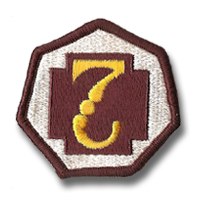
 10th Field Hopsital DI
10th Field Hopsital DI



